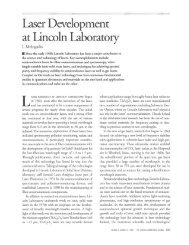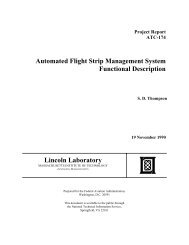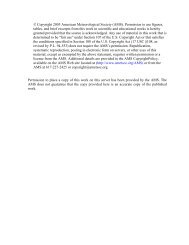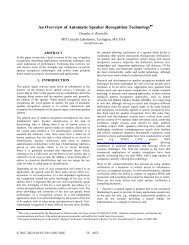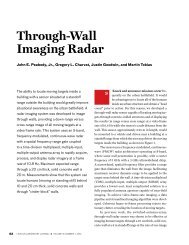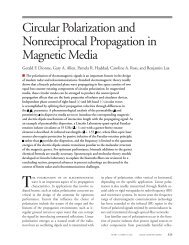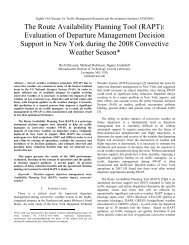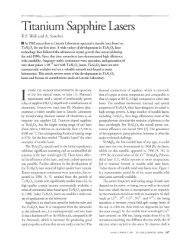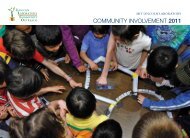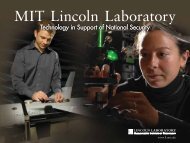2011 Annual Report - MIT Lincoln Laboratory
2011 Annual Report - MIT Lincoln Laboratory
2011 Annual Report - MIT Lincoln Laboratory
You also want an ePaper? Increase the reach of your titles
YUMPU automatically turns print PDFs into web optimized ePapers that Google loves.
technology transfer<br />
Economic Impact and Technology Transfer<br />
<strong>Lincoln</strong> <strong>Laboratory</strong>’s research and development<br />
activities strengthen both the nation’s technology<br />
base and its economy. The continuing development<br />
of new capabilities and emerging enabling technologies<br />
that are transitioned rapidly to the military<br />
services, government agencies, and industry<br />
helps ensure not only that advanced technology<br />
is available to the U.S. military services and<br />
government agencies, but also that U.S. industry is<br />
at the forefront of technical innovation.<br />
Technology transfer is accomplished through deliv-<br />
eries of hardware, software, algorithms, or advanced<br />
architecture concepts; Small Business Technology<br />
Transfer joint research partnerships with local<br />
businesses; Cooperative Research and Development<br />
Agreements that are privately funded by businesses;<br />
and the licensing of <strong>MIT</strong> patents to companies.<br />
Economic Impact<br />
During fiscal year <strong>2011</strong>, the <strong>Laboratory</strong> issued<br />
subcontracts with a value that exceeded $434<br />
million. In <strong>2011</strong>, the <strong>Laboratory</strong> purchased more<br />
than $242 million in goods and services from New<br />
England companies, with approximately $209<br />
million placed locally in Massachusetts. Small<br />
businesses—which supply construction, maintenance,<br />
fabrication, and professional technical<br />
services in addition to commercial equipment<br />
and material—are primary beneficiaries of the<br />
<strong>Laboratory</strong>’s outside procurement program. In<br />
<strong>2011</strong>, 53.4% of subcontracts were awarded to small<br />
businesses of all types. The <strong>Laboratory</strong>’s Small<br />
Business Office is committed to an aggressive<br />
program designed to afford small business<br />
concerns the maximum opportunity to compete for<br />
purchase orders.<br />
Technology Transfer Activities<br />
Air and Missile Defense Technology<br />
■ The U.S. Navy is acquiring the Air and Missile<br />
Defense Radar (AMDR) to provide nextgeneration,<br />
integrated air and missile defense<br />
capability for future surface combatants. To<br />
establish a baseline for the ballistic missile<br />
defense mission, the <strong>Laboratory</strong> developed a<br />
prototype architecture for tracking and discriminating<br />
targets in all phases of ballistic flight. The<br />
16 <strong>2011</strong> <strong>Annual</strong> <strong>Report</strong><br />
AMDR discrimination architecture was delivered to<br />
the government, and its component algorithms will<br />
be transferred to industry.<br />
■ The <strong>Laboratory</strong> developed the prototype autonomous<br />
processing and sensor control computer for the<br />
Missile Defense Agency’s airborne infrared optical<br />
sensing capability for tracking ballistic missile threats.<br />
The hardware design and prototype software implementation<br />
was then transferred to Raytheon for further<br />
development and production.<br />
■ The <strong>Laboratory</strong> has transferred open system architecture<br />
technical concepts, algorithms, and standards<br />
for use in the U.S. Air Force’s next-generation radar<br />
systems.<br />
■ Iterative Clutter Calibration, an antenna calibration<br />
technique for airborne radars, is being transferred to<br />
Northrop Grumman, Boeing, and the Commonwealth<br />
of Australia (through the U.S. Air Force). The technique<br />
uses ground clutter to improve the calibration of an<br />
airborne radar antenna to compensate for effects such<br />
as airframe interaction and failed antenna elements.<br />
Two patents have been filed.<br />
Communication Systems<br />
■ The VOCALINC forensic-style speaker comparison<br />
tool, which employs state-of-the-art session and<br />
channel compensation and speech enhancement, was<br />
transferred to the Federal Bureau of Investigation, U.S.<br />
Secret Service, and the intelligence community.<br />
■ A <strong>Laboratory</strong>-developed government reference<br />
implementation of a high-data-rate waveform for<br />
intelligence, surveillance, and reconnaissance (ISR)<br />
applications was released to 15 industry participants.<br />
The release included VHDL (a hardware description<br />
language), software, models, test vectors, and<br />
documentation.<br />
■ The Large Aperture Ka-band Test Terminal was<br />
upgraded to characterize the on-orbit performance of<br />
the wideband bypass mode on the Wideband Global<br />
Satellite (WGS) Flights 4 and above. The terminal was<br />
transferred to the WGS program office and deployed<br />
to Camp Parks, California, in preparation for postlaunch<br />
testing.



